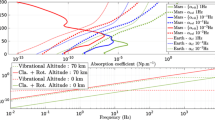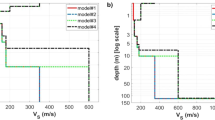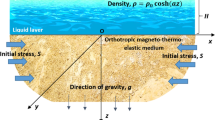Abstract
Meteor impacts and/or meteor events generate body and surface seismic waves on the surface of a planet. When meteoroids burst in the atmosphere, they generate shock waves that subsequently convert into acoustic waves in the atmosphere and seismic waves in the ground. This effect can be modeled as the amplitude of Rayleigh and other Spheroidal modes excitation, due to atmospheric/ground coupling effects.
First, an inversion of the seismic source of Chelyabinsk superbolide is performed. We develop an approach in order to model a line source in the atmosphere, corresponding to the consecutive generation of shock waves by the interaction with the atmosphere. The model is based on the known trajectory. We calculate the synthetic seismograms of Rayleigh waves associated with the event by the summation of normal modes of a model of the solid part and the atmosphere of the planet. Through an inversion technique based on singular value decomposition, we perform a full Rayleigh wave inversion and we provide solutions for the moment magnitude.
SEIS will likely detect seismic waves generated by impacts and the later might be further located by remote sensing differential processing. In the case of Mars, we use the same method to obtain waveforms associated with impacts on the planetary surface or in low altitudes in the Martian atmosphere. We show that the contribution of the fundamental spheroidal solid mode is dominating the waveforms, compared to that of the first two overtones. We perform an amplitude comparison and we show that small impactors (diameter of 0.5 to 2 m), can be detected by the SEIS VBB seismometer of InSight mission, even in short epicentral distances, in the higher frequencies of the Rayleigh waves. We perform an analysis based on impact rate estimations and we calculate the number of detectable events of 1 meter diameter meteor impacts to be 6.7 to 13.4 per 1 Martian year for a \(Q=500\).





















Similar content being viewed by others
References
W. Banerdt, S. Smrekar, P. Lognonné, T. Spohn, S.W. Asmar, D. Banfield, L. Boschi, U. Christensen, V. Dehant, W. Folkner, D. Giardini, W. Goetze, M. Golombek, M. Grott, T. Hudson, C. Johnson, G. Kargl, N. Kobayashi, J. Maki, K. Hurst (the InSight Team), InSight: a discovery mission to explore the interior of Mars. Lunar Planet. Sci. Conf. 44, 1915 (2013)
C. Bassin, G. Laske, G. Masters, The current limits of resolution for surface wave tomography in North America. Eos Trans. AGU 81, F897 (2000)
A. Ben-Menahem, Source parameters of the Siberian explosion of June 30, 1908, from analysis and synthesis of seismic signals at four stations. Phys. Earth Planet. Inter. 11, 1–35 (1975)
J. Borovička, P. Spurný, P. Brown, P. Wiegert, P. Kalenda, D. Clark, L. Shrbený, The trajectory, structure and origin of the Chelyabinsk asteroidal impactor. Nature 503, 235–237 (2013). https://doi.org/10.1038/nature12671
P. Brown, J. Assink, L. Astiz, R. Blaauw, M. Boslough, J. Borovička, N. Brachet, D. Brown, M. Campbell-Brown, L. Ceranna, W. Cooke, C. De Groot-Hedlin, D.P. Drob, W. Edwards, L. Evers, M. Garces, J. Gill, M. Hedlin, A. Kingery, Z. Krzeminski, A 500-kiloton airburst over Chelyabinsk and an enhanced hazard from small impactors. Nature 503, 238–241 (2013). https://doi.org/10.1038/nature12741
I. Daubar, A. McEwen, S. Byrne, M. Kennedy, B. Ivanov, The current Martian cratering rate. Icarus 225(1), 506–516 (2013). https://doi.org/10.1016/j.icarus.2013.04.009
I. Daubar, L. Philippe, N.A. Teanby, K. Miljković, J. Stefanovic, J. Vaubaillon, B. Kenda, T. Kawamura, J. Clinton, A. Lucas, M. Drilleau, C. Yana, G.S. Collins, D. Banfield, M. Golombek, S. Kedar, N. Schmerr, R. Garcia, S. Rodriguez, T. Gudkova, S. May, M. Banks, J. Maki, E. Sansom, F. Karakostas, M. Panning, N. Fuji, J. Wookey, M. van Driel, M. Lemmon, V. Ansan, M. Böse, S. Stähler, H. Kanamori, J. Richardson, S. Smrekar, W.B. Banerdt, Impact-seismic investigations of the InSight mission. Space Sci. Rev. (2018). https://doi.org/10.1007/s11214-018-0562-x
A. Dziewonski, D. Anderson, Preliminary reference Earth model. Phys. Earth Planet. Inter. 25, 297–356 (1981). https://doi.org/10.1016/0031-9201(81)90046-7
W.N. Edwards, Meteor generated infrasound: theory and observation, in Infrasound Monitoring for Atmospheric Studies, ed. by A. Le Pichon, E. Blanc, A. Hauchecorne (Springer, Dordrecht, 2009), pp. 361–414. https://doi.org/10.1007/978-1-4020-9508-5-12
C. de Groot-Hedlin, M.A. Hedlin, Infrasound detection of the Chelyabinsk meteor at the USArray. Earth Planet. Sci. Lett. 402, 337–345 (2014), special issue on USArray science. https://doi.org/10.1016/j.epsl.2014.01.031
T.C. Hanks, H. Kanamori, A moment magnitude scale. J. Geophys. Res., Solid Earth 84(B5), 2348–2350 (1979). https://doi.org/10.1029/JB084iB05p02348
S. Heimann, A. González, R. Wang, S. Cesca, T. Dahm, Seismic characterization of the Chelyabinsk meteor’s terminal explosion. Seismol. Res. Lett. 84(6), 1021 (2013). https://doi.org/10.1785/0220130042
K.A. Holsapple, Users Manual: Crater Sizes from Explosions or Impacts by Keith A. Holsapple, (2003, 2007, 2015, 2017, 2018). http://keith.aa.washington.edu/craterdata/scaling/index.htm, accessed: 2018-02-16
International Seismological Centre (2013). On-line Bulletin. Internatl. Seismol. Cent., Thatcham, United Kingdom. http://www.isc.ac.uk
D. Komatitsch, J. Tromp, Spectral-element simulations of global seismic wave propagation—I. Validation. Geophys. J. Int. 149(2), 390–412 (2002a). https://doi.org/10.1046/j.1365-246X.2002.01653.x
D. Komatitsch, J. Tromp, Spectral-element simulations of global seismic wave propagation—II. Three-dimensional models, oceans, rotation and self-gravitation. Geophys. J. Int. 150(1), 303–318 (2002b)
A. Le Pichon, L. Ceranna, C. Pilger, P. Mialle, D. Brown, P. Herry, N. Brachet, The 2013 Russian fireball largest ever detected by ctbto infrasound sensors. Geophys. Res. Lett. 40(14), 3732–3737 (2013). https://doi.org/10.1002/grl.50619
P. Lognonné, B. Mosser, F.A. Dahlen, Excitation of Jovian Seismic Waves by the Shoemaker-Levy 9 Cometary Impact. Icarus 11, 180–195 (1994)
P. Lognonné, E. Clévédé, H. Kanamori, Computation of seismograms and atmospheric oscillations by normal-mode summation for a spherical Earth model with realistic atmosphere. Geophys. J. Int. 135(2), 388–406 (1998). https://doi.org/10.1046/j.1365-246X.1998.00665.x
M.C. Malin, J.F. Bell, B.A. Cantor, M.A. Caplinger, W.M. Calvin, R.T. Clancy, K.S. Edgett, L. Edwards, R.M. Haberle, P.B. James, S.W. Lee, M.A. Ravine, P.C. Thomas, M.J. Wolff, Context camera investigation on board the Mars reconnaissance orbiter. J. Geophys. Res., Planets 112(E5), E05S04 (2007). https://doi.org/10.1029/2006JE002808
K. Miljković, E.K. Sansom, I.J. Daubar, F. Karakostas, P. Lognonné, Fate of meteoroid impacts on Mars detectable by the InSight mission, in Lunar and Planetary Science Conference. Lunar and Planetary Inst. Technical Report, vol. 47 (2016), p. 1768
S. Myers, M. Begnaud, S. Ballard, M. Pasyanos, W. Phillips, A. Ramirez, M. Antolik, K. Hutchenson, G. Wagner, J. Dwyer, C. Rowe, D. Russell, A crust and upper mantle model of Eurasia and North Africa for Pn travel time calculation. Bull. Seismol. Soc. Am. 100, 640–646 (2010)
E.A. Okal, D.L. Anderson, Theoretical models for Mars and their seismic properties. Icarus 33(3), 514–528 (1978). https://doi.org/10.1016/0019-1035(78)90187-2
J.M. Picone, A.E. Hedin, D.P. Drob, A.C. Aikin, Nrlmsise-00 empirical model of the atmosphere: statistical comparisons and scientific issues. J. Geophys. Res. Space Phys. 107(A12), SIA 15-1–SIA 15-16 (2002). https://doi.org/10.1029/2002JA009430
V. Rakoto, P. Lognonné, L. Rolland, P. Coïsson, Tsunami wave height estimation from GPS-derived ionospheric data. J. Geophys. Res. Space Phys. 123(5), 4329–4348 (2018). https://doi.org/10.1002/2017JA024654
D.O. ReVelle, Acoustics of meteors—effects of the atmospheric temperature and wind structure on the sounds produced by meteors. Ph.D. Thesis, University of Michigan, Ann Arbor, MI (1974)
V. Shuvalov, V. Svetsov, O. Popova, D. Glazachev, Numerical model of the Chelyabinsk meteoroid as a strengthless object. Planet. Space Sci. 147, 38–47 (2017). https://doi.org/10.1016/j.pss.2017.05.011
A. Spiga, F. Forget, S. Lewis, D.P. Hinson, Structure and dynamics of the convective boundary layer on Mars as inferred from large-eddy simulations and remote-sensing measurements. Q. J. R. Meteorol. Soc. 136, 414–428 (2010). https://doi.org/10.1002/qj.563
J. Stevanović, N.A. Teanby, J. Wookey, N. Selby, I.J. Daubar, J. Vaubaillon, R. Garcia, Bolide airbursts as a seismic source for the 2018 Mars InSight mission. Space Sci. Rev. 211(1), 525–545 (2017). https://doi.org/10.1007/s11214-016-0327-3
B. Tauzin, E. Debayle, C. Quantin, N. Coltic, Seismoacoustic coupling induced by the breakup of the 15 February 2013 Chelyabinsk meteor. Geophys. Res. Lett. 40, 1–5 (2013). https://doi.org/10.1002/grl.50683
N. Teanby, Predicted detection rates of regional-scale meteorite impacts on Mars with the InSight short-period seismometer. Icarus 256, 49–62 (2015). https://doi.org/10.1016/j.icarus.2015.04.012
M. Tesauro, M.K. Kaban, S.A.P.L. Cloetingh, EuCRUST-07: a new reference model for the European crust. Geophys. Res. Lett. 35(5), L05313 (2008). https://doi.org/10.1029/2007GL032244
J. Zuluaga, I. Ferrin, S. Geens, The orbit of the Chelyabinsk event impactor as reconstructed from amateur and public footage (2013). arXiv:1303.1796
Acknowledgements
The facilities of IRIS Data Services, and specifically the IRIS Data Management Center, were used for access to waveforms, related metadata, and/or derived products used in this study. IRIS Data Services are funded through the Seismological Facilities for the Advancement of Geoscience and EarthScope (SAGE) Proposal of the National Science Foundation under Cooperative Agreement EAR-1261681. Spectral Element Modeling was performed on the HPC resources of LANL. A portion of this research was carried out at the Jet Propulsion Laboratory, California Institute of Technology, under a contract with the National Aeronautics and Space Administration. F. Karakostas acknowledges the financial support of the UnivEarthS Labex program at Université Sorbonne Paris Cité (ANR-10-LABX-0023 and ANR-11-IDEX-0005-02) and of the SODERN company for his Ph.D. financial support. KM research is fully supported by the Australian Government (project numbers DE180100584 and DP180100661). We thank Raphaël Garcia and two anonymous reviewers for their constructive reviews. This is IPGP contribution 3993. This is InSight contribution Number 73.
Author information
Authors and Affiliations
Corresponding author
Additional information
The InSight Mission to Mars II
Edited by William B. Banerdt and Christopher T. Russell
Electronic Supplementary Material
Below are the links to the electronic supplementary material.
Rights and permissions
About this article
Cite this article
Karakostas, F., Rakoto, V., Lognonné, P. et al. Inversion of Meteor Rayleigh Waves on Earth and Modeling of Air Coupled Rayleigh Waves on Mars. Space Sci Rev 214, 127 (2018). https://doi.org/10.1007/s11214-018-0566-6
Received:
Accepted:
Published:
DOI: https://doi.org/10.1007/s11214-018-0566-6




